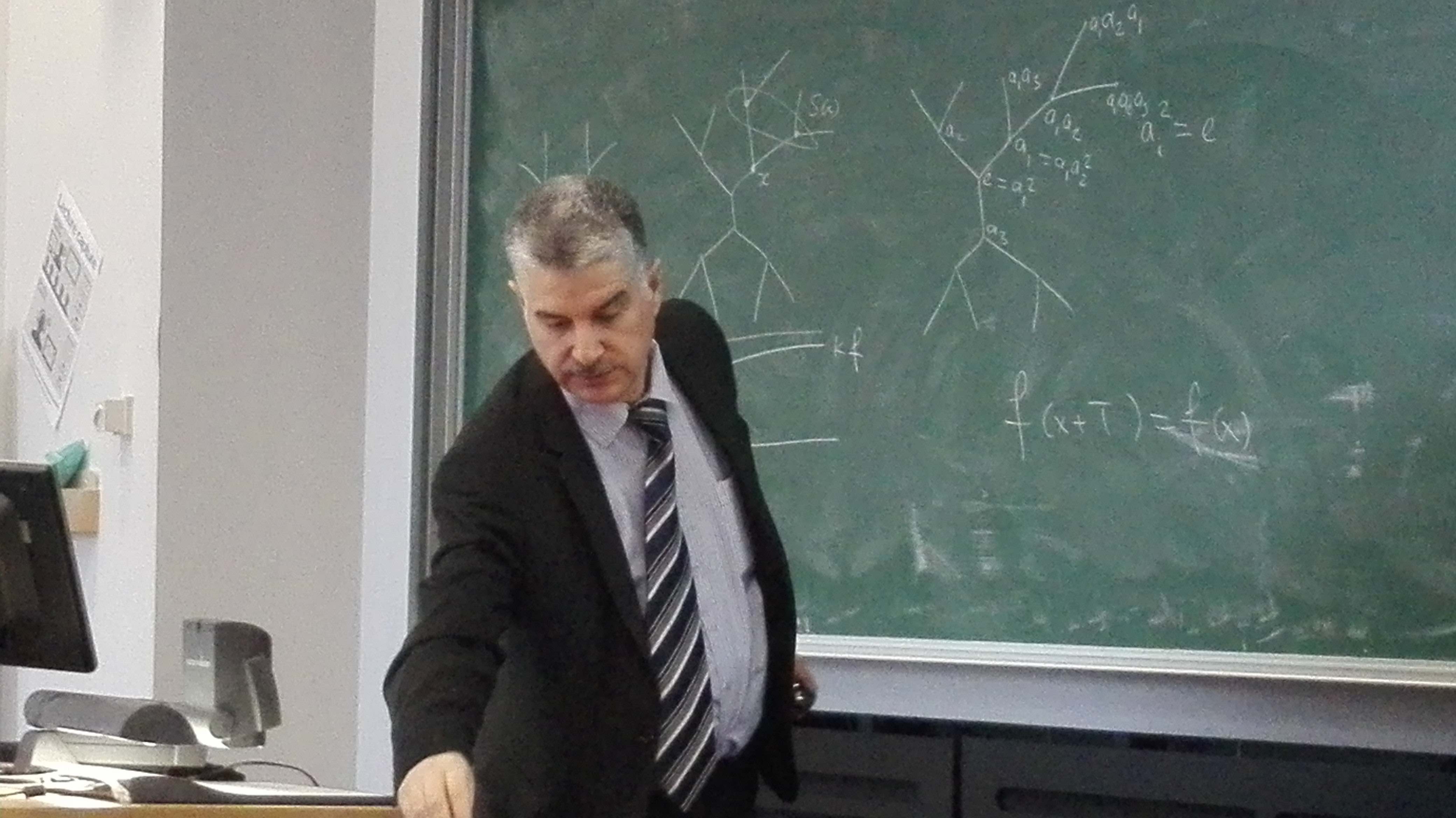Warwick Statistical Mechanics Seminar
in the Department of Mathematics
 |
This term, all seminars take place Thursdays at 2pm, room MS.04 (Zeeman Building), unless indicated otherwise. |
 Utkir Rozikov, 04.02.2016 |
| 05.10.2017 | Yan Fyodorov (Kings College) Exponential number of equilibria and depinning threshold for a directed polymer in a random potential. Using the Kac-Rice approach, we show that the mean number of all possible equilibria of an elastic line (directed polymer), confined in a harmonic well and submitted to a quenched random Gaussian potential, grows exponentially ~exp(Lr) with its length L. The growth rate is found to be directly related to the generalized Lyapunov exponent of an associated Anderson localization problem of a 1d Schroedinger equation in a random potential. For strong confinement, the rate r is small and given by a non-perturbative (instanton) contribution to the Lyapunov exponent. For weak confinement, the rate r is found to be proportional to the inverse Larkin length of the pinning theory. As an application, identifying the depinning with a landscape â€topology trivialization†phenomenon, we obtain an upper bound for the depinning threshold f_c, in presence of an applied force. The presentation is based on the joint work arXiv:1703.10066 with P.Le Doussal, A. Rosso and C. Texier. |
| 12.10.2017 | Alexandre Stauffer (University of Bath) Activated Random Walks We consider the activated random walk model on general vertex-transitive graphs. A central question is whether the critical density mu_c for sustained activity is strictly between 0 and 1. It was known that mu_c>0 on Z^d, dgeq 1, and that mu_c<1 on Z for small enough sleeping rate. We show that mu_c o 0 as lambda o 0 in all transient graphs, implying that mu_c<1 for small enough sleeping rate. We also show that mu_c<1 for any sleeping rate in any graph in which simple random walk has positive speed. Furthermore, we prove that mu_c>0 in any amenable graph, and that mu_cin(0,1) for any sleeping rate on regular trees. Based on a joint work with Lorenzo Taggi. |
| 19.10.2017 | Vladislav Vysotskiy (University of Sussex) Convex hulls of random walks Consider the probability that the convex hull of an n-step random walk in R^d does not absorb the origin, which in dimension one means that the trajectory of the walk does not change its sign. The remarkable formula of Sparre Andersen (1949) states that any one-dimensional random walk with symmetric continuous distribution of increments stays positive with the probability (2n-1)!!/(2n)!!, which does not depend on the distribution. We prove a multidimensional distribution-free counterpart of this result and give an explicit tractable formula for the absorption probability. Our idea is to show that the absorption problem is equivalent to a geometric problem on counting the number of Weyl chambers in R^n intersected by a generic linear subspace of codimension d. This method also yields absorption probabilities for convex hulls of random walk bridges and even joint convex hulls of several symmetric random walks and random bridges. As the main application of these results, we obtain explicit distribution-free formulas for the expected number of k-dimensional faces (e.g., vertices for k=0 and hyperfaces for k = d-1) in convex hulls of random walks. This is a joint work with Zakhar Kabluchko (Munster) and Dmitry Zaporozhets (St. Petersburg). |
| 26.10.2017 | Costanza Benassi (University of Warwick) Random loop models: conjectures and results Random loop models appear in a great variety of situations in both the probability and mathematical physics literature. Recently some striking conjectures have been proposed about the appearance of extended loops and the distribution of their lengths, which is expected to be a member of the Poisson Dirichlet distribution family. We propose a general class of models for interacting loops on a lattice, and we investigate how to validate these conjecture exploiting their relationship with a generalised random current model. |
| 02.11.2017 | Nils Berglund (Université d Orléans) Metastability in stochastic Allen–Cahn PDEs Stochastic processes subject to weak noise often show a metastable behaviour, meaning that they converge to equilibrium extremely slowly; typically, the convergence time is exponentially large in the inverse of the variance of the noise (Arrhenius law). In the case of finite-dimensional Ito stochastic differential equations, the large-deviation theory developed in the 1970s by Freidlin and Wentzell allows to prove such Arrhenius laws and compute their exponent. Sharper asymptotics for relaxation times, including the prefactor of the exponential term (Eyring–Kramers laws) are known, for instance, if the stochastic differential equation involves a gradient drift term and homogeneous noise. One approach that has been very successful in proving Eyring–Kramers laws, developed by Bovier, Eckhoff, Gayrard and Klein around 2005, relies on potential theory. I will describe Eyring–Kramers laws for some parabolic stochastic PDEs such as the Allen–Cahn equation on the torus. In dimension 1, an Arrhenius law was obtained in the 1980s by Faris and Jona-Lasinio, using a large-deviation principle. The potential-theoretic approach allows us to compute the prefactor, which turns out to involve a Fredholm determinant. In dimensions 2 and 3, the equation needs to be renormalized, which turns the Fredholm determinant into a Carleman–Fredholm determinant. Based on joint work with Barbara Gentz (Bielefeld), and with Giacomo Di Gesù (Vienna) and Hendrik Weber (Warwick). |
| 09.11.2017 | Sergio Yuhjtman (University of Buenos Aires) Cluster expansion using Penrose tree-graph identity The cluster expansion method is very useful to solve many models in statistical mechanics and quantum field theory. It can be applied whenever the system is formulated as a gas of weakly interacting polymers. I will present a result by Aldo Procacci and me that leads to improved bounds for the convergence of the expansion. We exploit a combinatorial identity by O. Penrose by considering minimum spanning trees. We will see with some detail the particular case of a classical gas of point particles with pair interaction. |
| 16.11.2017 | Adam Bowditch (University of Warwick) Regeneration structures for random walk models Regeneration techniques have proved to be an important tool for random walks in random environments since the early 1980s. In this talk we give an overview of some of the uses and limitations to these methods. We then discuss a related technique of Bolthausen and Sznitman that draws an equivalence between the static and dynamic points of view of the random walk and extend some results where regeneration techniques alone are not sufficient. As our main motivation we consider the Bouchaud trap model and biased random walks on supercritical Galton-Watson trees with leaves. |
| 23.11.2017 | Anna Maltsev (Queen Mary University) What the Ising model can tell us about intracellular calcium signals Intracellular calcium signals represent a universal mechanism of cell function. Messages carried by calcium are local, rapid, and powerful enough to be delivered over the thermal noise. A higher signal to noise ratio is achieved by a cooperative action of calcium release channels arranged in clusters containing a few to several hundred release channels. The channels synchronize their openings via Ca-induced-Ca-release, generating high-amplitude local calcium signals. Despite positive feedback nature of the activation, calcium signals are strictly confined in time and space by an unexplained termination mechanism. We construct an isomorphism between such molecular clusters and an Ising model and demonstrate that the collective transition of release channels from an open to a closed state is identical to the phase transition associated with the reversal of magnetic field. This is joint work with Prof. Stern laboratory at the National Institutes of Health. |
| 30.11.2017 | Enrico Scalas (University of Sussex) Random exchange models for the distribution of wealth In the last 15-20 years, mathematicians and physicists applied the ideas of statistical physics to models for the distribution of wealth. After a brief and non-exhaustive summary of the past relevant literature, I will present a survey of results obtained by my coworkers and myself in this field. References [1] Garibaldi, Ubaldo and Scalas, Enrico (2010) Finitary Probabilistic Methods in Econophysics, Cambridge University Press, Cambridge UK. [2] Scalas, Enrico (2016) Random exchange models and the distribution of wealth. European Physical Journal - Special Topics, 225. pp. 3293-3298. ISSN 1951-6355. https://link.springer.com/article/10.1140/epjst/e2016-60162-3 [3] During, Bertram, Georgiou, Nicos and Scalas, Enrico (2017) A stylised model for wealth distribution. In: Akura, Yuji and Kirman, Alan (eds.) Economic Foundations of Social Complexity Science. Springer Singapore, Singapore, pp. 95-117. ISBN 9789811057045 http://www.springer.com/gb/book/9789811057045 https://arxiv.org/abs/1609.08978 |
| 07.12.2017 | Alexandre Krajenbrink (ENS-Paris) Exact short time solutions of the KPZ equation… … from a physicist point of view In the past decade, explicit solutions have been found for the Kardar-Parisi-Zhang (KPZ) equation. Quite remarkably, they always express the moment generating function of the Cole-Hopf solution of the KPZ equation as a Fredholm Pfaffian or Fredholm Determinant. These algebraic structures are quite common in the field of Random Matrix Theory (RMT) and Determinant Point Processes and therefore allow to draw connexions between asymptotic RMT distributions (Tracy-Widom distribution), non-interacting fermions at finite temperature in quantum mechanics and height solutions of the KPZ equation. I will first review the techniques commonly used in the physics literature to study the KPZ equation (the replica method, the Bethe Ansatz solution of the Lieb-Liniger model) and show how it has allowed to obtain solutions for the KPZ equation. I will then focus on the Brownian initial condition and show how to extract the exact distribution of the solution of the KPZ equation from its Fredholm determinant representation at short time in terms of a Large Deviation Principle. For this initial condition, It has been numerically conjectured by Meerson et al. (2016) that the large deviation function at short time exhibits a second-order phase transition using Weak Noise Theory. Starting from the exact Fredhom determinant obtained by Imamura and Sasamoto (2012), I will prove this conjecture, provide the analytic expression of the critical field where the transition occurs and compare my predictions with the numerical estimates of Meerson et al. Reference: Alexandre Krajenbrink, Pierre Le Doussal Exact short-time height distribution in the one-dimensional Kardar-Parisi-Zhang equation with Brownian initial condition Phys. Rev. E. 96 020102 (2017) |